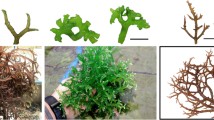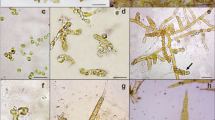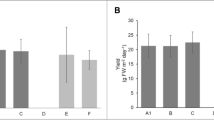Abstract
Commercial cultivation of seaweeds has improved the livelihood of coastal fishermen in several developing countries. Along with success story of the commercial cultivation of popular carragenophyte Kappaphycus alvarezii (Rhodophyta), there have been concerns about its invasive tendencies. Substantial quantities of algal fragments disperse during farm maintenance, specifically during harvesting. It is believed that the drifting fragments eventually die on the sea bottom. In the present investigation, drifting fragments (live, semi-bleached, and bleached) were incubated under different salinity (20, 25, 30, 35, and 40 ‰) and temperature (15, 20, 25, 30, and 35 °C) regimes to record daily growth rate (DGR). NO3-N, PO4-P, and SiO3-Si uptake was evaluated for live fragments under similar culture conditions at 72 h interval in case of live fragments. The highest uptake (99 %) was recorded for NO3-N at 30 °C in 30 ‰, while the lowest (62 %) was recorded for SiO3-Si at 35 °C in 20 ‰. After 30 days of laboratory incubation, culture fragments were outplanted into the open sea to evaluate their survival efficacy and growth. The highest DGR (7.116 %) was observed in fragments which were priorly incubated at 20 °C in 20 ‰ salinity followed by a DGR of 4.85 % at 30 °C in 30 ‰. The overall findings reveal that conducive temperature and salinity, along with survival efficiency due to bioavailability of required nutrients and regeneration capacity of drifting fragments, play crucial role in determining the establishment of K. alvarezii population in the wild.







Similar content being viewed by others
References
Anderson DM, Glibert PM, Burkholder JM (2002) Harmful algal blooms and eutrophication: nutrient sources, composition and consequences. Estuaries 25:704–726
Araújo PG, Ribeiro ALNL, Yokoya NS, Fujii MT (2014) Temperature and salinity responses of drifting specimens of Kappaphycus alvarezii (Gigartinales, Rhodophyta) farmed on the Brazilian tropical coast. J Appl Phycol 26:1979–1988
Bindu MS, Levine IA (2011) Commercial red seaweed Kappaphycus alvarezii an overview on farming and environment. J Appl Phycol 23:789–796
Bulboa CR, Paula EJ, Chow F (2008) Germination and survival of tetraspores of Kappaphycus alvarezii (Solieriaceae, Rhodophyta) introduced in subtropical waters of Brazil. Phycol Res 56:39–45
Chandrasekaran S, Nagendran NA, Pandiaraja D, Krishnankutty N, Kamalakannan B (2008) Bioinvasion of K. alvarezii on corals in the Gulf of Mannar, India. Curr Sci 94:1167–1172
Chung IC, Hwang RL, Lin SH, Wu TM, Wu JY, Su SW, Chen CS, Lee TM (2007) Nutrients, temperature, and salinity as primary factors influencing the temporal dynamics of macroalgal abundance and assemblage structure on a reef of Du- Lang Bay in Taitung in southeastern Taiwan. Bot Stud 48:419–433
Conklin EJ, Smith JE (2005) Abundance and spread of the invasive red algae, Kappaphycus spp. in Kane’ohe Bay, Hawai’I and experimental assessment of management options. Biol Invasions 7:1029–1039
Dawes CJ (1989) Temperature acclimation in cultured Eucheuma isiforme from Florida and E. alvarezii from the Philippines. J Appl Phycol 1:59–69
Eswaran K, Ghosh PK, Siddhanta AK, Patolia JS, Periyasamy C, Mehta AS, Mody KH, Ramavat BK, Prasad K, Rajyaguru MR, Reddy CRK, Pandya JB, Tewari A (2004) Integrated method for production of carrageenan and liquid fertilizer from fresh seaweeds US patent 6983479
Eswaran K, Ghosh PK, SubbaRao PV, Mairh OP (2006) Field cultivation of Kappaphycus alvarezii in India. In: Tewari A (ed) Recent Advances on Applied Aspects of Indian Marine Algae with Reference to Global Scenario. Central Salt and Marine Chemicals Research Institute Publication, vol-1. pp 250–261
Grassoff K, Kremling K, Ehrhardt M (1976) Methods of seawater analysis. Verlag Chemie, Weinheim, WILEY-VCH Verlag GmbH, D-69469 Weinheim, p 317
Halling C, Wikström SA, Lilliesköld-Sjöö G, Mörk E, Lundsør E, Zuccarello GC (2013) Introduction of Asian strains and low genetic variation in farmed seaweeds: Indications for new management practices. J Appl Phycol 25:89–95
Hayashi L, Santos A, Faria G, Nunes B, Souza M, Fonseca A, Barreto P, Oliveira E, Bouzon Z (2011) Kappaphycus alvarezii (Rhodophyta, Areschougiaceae) cultivated in subtropical waters in Southern Brazil. J Appl Phycol 23:337–343
Herren LW, Walters LG, Beach KS (2013) Fragment production and recruitment ecology of the red alga Laurencia poiteaui in Florida Bay, USA. J Exp Mar Bio Ecol 440:192–199
Hurtado AQ, Montaño MNE, Martinez-Goss MR (2013) Commercial production of carrageenophytes in the Philippines:ensuring long-term sustainability for the industry. J Appl Phycol 25:733–742
Lapointe BE, Bedford BJ (2007) Drift rhodophyte blooms emerge in Lee County, Florida, USA: evidence of escalating coastal eutrophication. Harmful Algae 6:421–437
Lirason T, Twide P (1993) Farming Eucheuma in Zanbiar, Tanzania. Hydrobiologia 260/261:353–355
Mairh OP, Soe-Htun U, Ohno M (1986) Culture of Eucheuma striatum (Rhodophyta, Solieriaceae) in subtropical waters of Shikoku, Japan. Bot Mar 29:185–191
Mairh OP, Zodape ST, Tewari A, Rajyaguru MR (1995) Culture of marine red algae Kappaphycus striatum (Schmitz) Doty on the Saurashtra region, west coast of India. Indian J Mar Sci 24:24–31
Mallea AJA, Villanueva FCA, Bernardi J, Cabrera R (2014) Ecological risk assessment of the introduction of exotic carrageenophytes in the tropical Western Atlantic. J Appl Phycol 26:2055–2063
Mandal SK, Mantri VA, Haldar S, Eswaran K, Ganesan M (2010) Invasion potential of Kappaphycus alvarezii on corals at Kurusadai Island, Gulf of Mannar, India. Algae 25:205–216
Mantri VA, Singh RP, Bijo AJ, Kumari P, Reddy CRK, Jha B (2011) Differential response of varying salinity and temperature on zoospore induction, regeneration and daily growth rate in Ulva fasciata (Chlorophyta, Ulvales). J Appl Phycol 23:243–250
Mathieson AC, Dawes CJ (1974) Ecological studies of Floridian Eucheuma (Rhodophyta, Gigartinales): II. Photosynthesis and respiration. Bull Mar Sci 34:274–285
Mendes LF, Vale LAS, Martins AP, Yokoya NS, Marinho-Sorinho E, Colepicolo P (2012) Influence of temperature, light and nutrients on the growth rates of the macroalga Gracilaria domingensis in synthetic seawater using experimental design. J Appl Phycol 24:1419–1426
Menendez M, Herrera J, Comin FA (2002) Effect of nitrogen and phosphorus supply on growth, chlorophyll content and tissue composition of the macroalga Chaetomorpha linum (O.F. Mull.) Kutz in a Mediterrenean coastal lagoon. Sci Mar 66:355–364
Mollin J, Braud JPA (1993) Eucheuma (Solieriaceae, Rhodophyta) cultivation test on the south-east coast of Madagascar. Hydrobiologia 260/261:373–378
Ohmi H, Shinmura I (1976) Growth of Eucheuma amakusaensis in the field culture. Bull Jap Soc Phycol 24:98–102
Ohno M, Orosco CA (1987) Growth rate of three species of Eucheuma, commercial red algae from the Philippines. In I. Umezaki (ed.), Scientific Survey of Marine algae and their Resources in the Philippine Islands. Privately published by the Laboratory of Fishery Resources, Graduate School of Agriculture, Kyoto University, pp 77–81
Ohno M, Largo DB, Ikurnoto T (1994) Growth rate, carrageenan yield and gel properties of culture kappa carrageenan producing red alga Kappaphycus alvarezii (Doty) Doty in the subtropical waters of Shikoku, Japan. J Appl Phycol 6:1–5
Ohno M, Nang HQ, Hirase ST (1996) Cultivation and carrageenan yield and quality of Kappaphycus alvarezii in the waters of Vietnam. J Appl Phycol 8:431–437
Oza RM, Tewari A, Rajyaguru MR, Goswamy S (1994) Laboratory and field culture of marine red alga Gracilaria verrucosa (Gracilariaceae, Rhodophyta). Ind J Mar Sci 23:157–161
Pedersen MF, Borum J (1997) Nutrient control of estuarine macro algae: growth strategy and the balance between nitrogen requirements and uptake. Mar Ecol Prog Ser 161:155–163
Periyasamy C, Anantharaman P, Balasubramanian T (2013) Social upliftment of coastal fisher women through seaweed (Kappaphycus alvarezii (Doty) Doty) farming in Tamil Nadu. India. J Appl Phycol 26:775–781
Pickering TD, Skelton P, Sulu JR (2007) Intentional introductions of commercially harvested alien seaweeds. Bot Mar 50:338–350
Reddy CRK, Krishnakumar GR, Siddhanta AK, Tewari A, Eswaran K (2003) In vitro somatic embryogenesis and regeneration of somatic embryos from pigmented callus of Kappaphycus alvarezii (Doty) Doty (Rhodophyta, Gigartinales). J Phycol 39:610–616
Saminathan KR, Ashok KS, Veeragurunathan V, Mantri VA (2014) Seedling production in industrially important agarophytes Gracilaria dura (Gracilariales, Rhodophyta). J Appl Phycol. doi:10.1007/s10811-014-0450-z
Tewari A, Basha S, Trivedi RH, Raghunathan C, Sravan Kumar, VG, Khambhaty Y, Joshi HV, Kotiwar OS (2006) Environmental impact assessment of Kappaphycus cultivation in India in context to global scenario. In: Tewari A (ed) Recent advances on applied aspects of Indian marine algae with reference to global scenario, Central Salt and Marine Chemicals Research Institute Publication, Vol-1, pp 262–287
Trono GC Jr, Ohno M (1989) Seasonality in the biomass production of the Eucheuma Strains in Northern Bohol, Philphines. In: Umezaki I (ed) scientific survey of marine algae and their resources in the Phillippine Islands. A Technical Report of the Ministry of Education, Science and Culture, Japan, pp 71–80
Vermeij M, Dailer M, Smith C (2009) Nutrient enrichment promotes survival and dispersal of drifting fragments in an invasive tropical macroalga. Coral Reefs 28:429–435
Zemke-White WL, Ohno M (1999) World seaweed utilisation: an end-of-century summary. J Appl Phycol 11:369–376
Acknowledgments
This work has been supported from the grants received for different projects from CSIR (PSC 0105; CSC 0105). The support under in-house project entitled ‘Scaled up farming for technology demonstration of promising seaweeds’ and grant-in-aid project ‘Impact of large-scale cultivation of seaweeds on coastal environment of India’ is also greatly acknowledged. Authors are highly obliged to anonymous reviewers and to the editor for their constructive suggestions that have improved the manuscript. We are also thankful to Prof. G. Arivarignan, Emeritus Professor, Applied Mathematics and Statistics, School of Mathematics, Madurai Kamaraj University, for his kind help in statistical analysis. This contribution has CSIR-CSMCRI PRIS registration number 059/2014.
Author information
Authors and Affiliations
Corresponding author
Rights and permissions
About this article
Cite this article
Mandal, S.K., Ajay, G., Monisha, N. et al. Differential response of varying temperature and salinity regimes on nutrient uptake of drifting fragments of Kappaphycus alvarezii: implication on survival and growth. J Appl Phycol 27, 1571–1581 (2015). https://doi.org/10.1007/s10811-014-0469-1
Received:
Revised:
Accepted:
Published:
Issue Date:
DOI: https://doi.org/10.1007/s10811-014-0469-1




